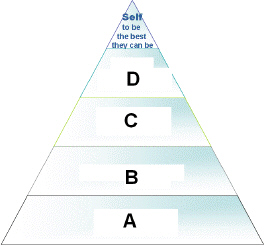Multiple Choice
Identify the
choice that best completes the statement or answers the question.
|
|
|
1.
|
Which concept is “Typically associated with the concept of
influence” in the chapter by Kelly (2009)?
a. |
Control |
c. |
Motivation |
b. |
Coordination |
d. |
Empowerment |
|
|
|
2.
|
Three key concepts exist in most leadership theories - select the item that is
not one of those key concepts
a. |
The leader |
c. |
The follower |
b. |
Power |
d. |
The relationship between leader and
follower |
|
|
|
3.
|
Select the item that is not normally described as a type of power
a. |
Reward |
d. |
Coercive |
b. |
Expert |
e. |
Illegitimate |
c. |
Affiliation
|
f. |
Referent
|
|
|
|
4.
|
Referent power can be built in many ways - select the item least likely to be
included
through:
a. |
Communication |
c. |
Relationship building |
b. |
Sharing information
|
d. |
Authority |
|
|
|
5.
|
To be effective as the leader, it is necessary to influence people to carry out
requests, support proposals and implement decisions. A variety of influence outcome may be
described - identify the outcome least likely to be associated with influence in the context of the
organization
a. |
Resistance |
c. |
Commitment |
b. |
Internalisation |
d. |
Compliance |
|
|
|
6.
|
Kelman (1958) outlined a process identifying three different types of influence
- select the item that does not describe one of those types of influence
a. |
Instrumental compliance |
c. |
Personal identification
|
b. |
Internalisation |
d. |
Rational persuasion |
|
|
|
7.
|
Which of the following are least likely to be considered as an influence
tactic
a. | Pressure | d. | Legitimating | b. | Consultation | e. | Apprising | c. | Internalisation | f. | Rational persuasion |
|
|
|
8.
|
Personality traits likely to be found in effective leaders are listed below,
select the item unlikely to be found in effective leaders
a. |
Personal integrity |
c. |
Self-confidence |
b. |
Low internal locus of
control |
d. |
Emotional stability
|
|
|
|
9.
|
Identify the item NOT a content theory of motivation
a. | Vroom's Expectancy Theory | c. | Hierarchy of
needs | b. | Herzberg's Motivation-Hygiene Theory | d. | Acquired Needs Theory
|
|
|
|
10.
|
select the item that is NOT a process theory of motivation
a. | McClelland's Acquired Needs Theory | c. | Locke’s Goal theory
| b. | Adams' Equity Theory | d. | Vroom's Expectancy Theory |
|
|
|
11.
|
Consider the Leadership Processes diagram below  Select the label for
box “D” in the diagram a. | Follower | c. | Leader Behaviour | b. | Influence process | d. | Outcomes |
|
|
|
12.
|
Consider Maslow's Hierarchy of Needs  Select the item that
is the correct label for the need depicted by the letter “C” in the diagram a. | Belonging | c. | Safety & Security | b. | Esteem | d. | Physiological |
|
|
|
13.
|
Consider Maslow's Hierarchy of Needs  Select the item that
is the correct label for the need depicted by the letter “D” in the diagram a. | Belonging | c. | Safety & Security | b. | Esteem | d. | Physiological |
|
|
|
14.
|
David McClelland is most noted for describing three types of motivational need,
which is not one of them?
a. | Achievement motivation | c. | Affiliation motivation
| b. | Autonomy motivation | d. | Authority/power motivation |
|
|
|
15.
|
Consider the Equity theory diagram below  Select the
appropriate label for “B” in the diagram a. | Doing well | c. | Unfair | b. | Equitable | d. | Fair |
|